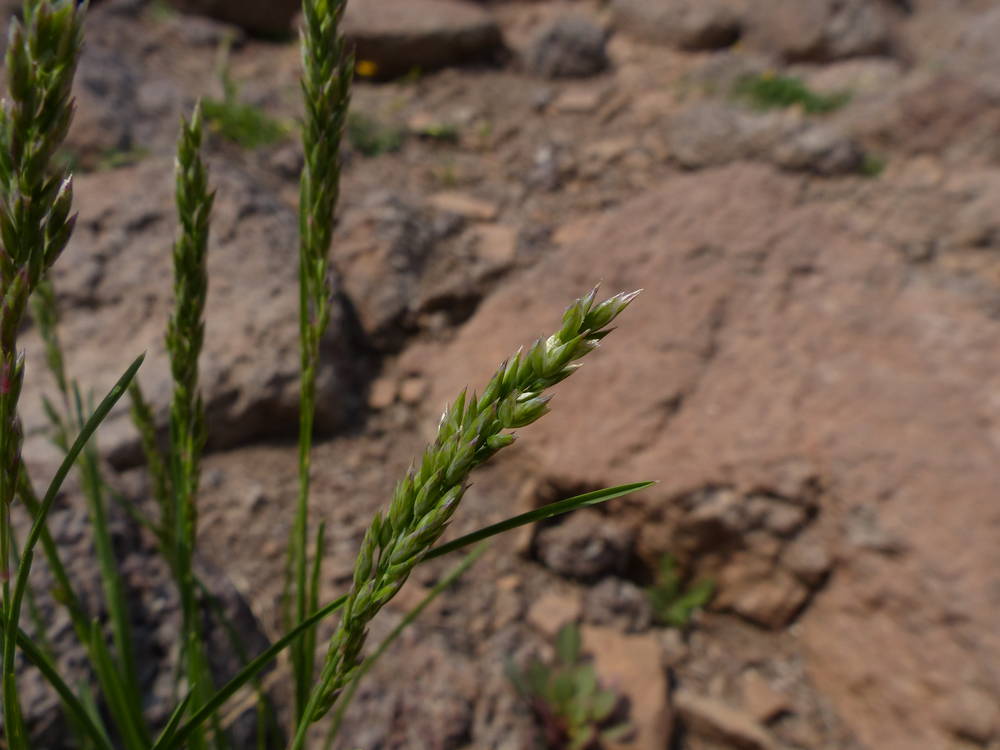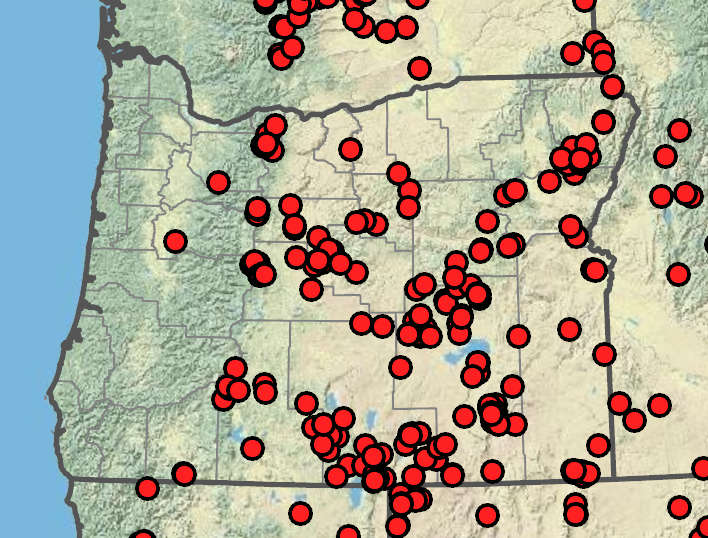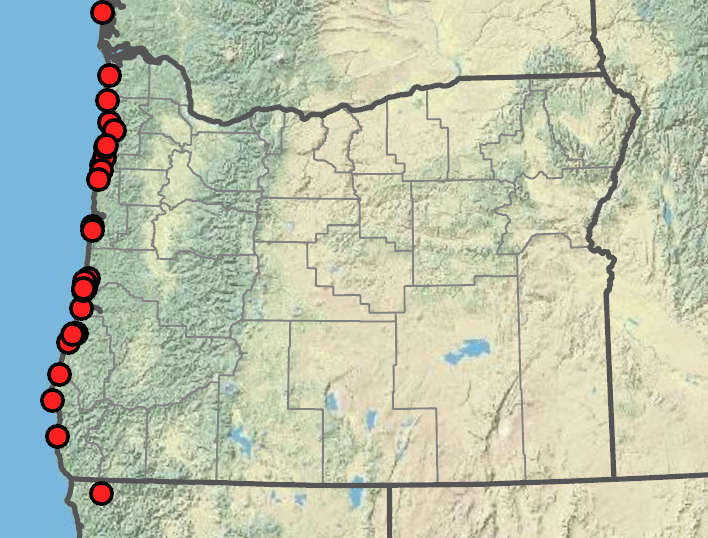Poa cusickii
Poa confinis
Cusick's bluegrass
coastline bluegrass
0.5–1.8 mm thick;
nodes terete, 0–2 exserted.
slender;
nodes terete, 0–1 exserted.
intravaginal or intra- and extravaginal.
mainly intravaginal; some extravaginal.
sheaths closed 25–75% of their length, bases of basal sheaths glabrous;
collars smooth or scabrous, glabrous, ligules of cauline leaves 1–3(6)mm;
tips truncate to acute, ligules of sterile shoots 0.2– 0.5(2.5)mm;
tips usually truncate;
blades involute to flat, 0.2– 3.5 mm wide; all about equal or the upper ones slightly reduced in length;
upper surface usually densely scabrous or hispidulous to softly puberulent, infrequently nearly smooth and glabrous;
lower surface smooth or scabrous; uppermost blade 0.5–5(6)cm.
sheaths closed 33–50% of their length; smooth, bases of basal sheaths glabrous;
collars smooth, glabrous;
ligules 0.5–1.5(2.2) mm, blades of tillers with upper surface moderately to densely scabrous or very short-hairy on and between the veins;
cauline blades involute, mostly filiform, 0.5–1(1.5)mm wide;
lower surfaces smooth;
upper surfaces sparsely scabrous on and between the veins; uppermost blade (0.5)1–5 cm long.
usually erect, tightly or loosely contracted, narrowly lanceoloid to ovoid, 2–10(12) cm;
spikelets 10–100;
branches erect or steeply ascending, 0.5–4(5)cm long, 1–3(5) per node, with 1–15 spikelets.
erect; ovoid, moderately to loosely congested, 1–5(7)cm;
spikelets fewer than 50;
branches erect to ascending, slightly lax, 0.5–3 cm, 1–2 per node.
broadly lanceolate to narrowly ovate; to 3 times as long as wide; (3)4–10 mm;
florets 2–6;
rachilla internodes 0.5–1.2 mm long.
to 3 times as long as wide; compact, 3–6(8)mm;
florets 2–5;
rachilla internodes glabrous or sparsely softly puberulent.
lanceolate;
lower glumes 3-veined, distinctly shorter than the lowest lemma.
slightly unequal;
keels smooth or scabrous;
lower glumes 2–4 mm long, 1–3-veined; about 67% as long as the lowest lemma;
upper glumes 2.9– 5 mm long.
glabrous or with short; sparse, sometimes diffuse cobwebby hairs less than 25% of the lemma length.
with sparse; diffuse; cobwebby hairs 1–2 mm, infrequently glabrous.
lanceolate to broadly lanceolate; (3)4–7 mm, distinctly keeled, membranous; smooth or sparsely to densely scabrous, glabrous throughout, or keels and/or marginal veins softly puberulent near the base;
tips acute.
lanceolate, 2.5– 4(4.5)mm, distinctly keeled, moderately to densely finely scabrous, glabrous throughout or keels and sometimes marginal veins proximally sparsely softly puberulent;
margins narrowly scarious;
tips acute.
vestigial and 0.1–0.2 mm, aborted late in development, or well developed and 2–3.5 mm.
vestigial and 0.1–0.2 mm or functional and 1.5–2 mm.
perennial; g ynodioecious, 7–30(35)cm tall, densely to loosely tufted, rhizomatous and stoloniferous;
rhizomes and stolons to 100 cm long.
Poa cusickii
Poa confinis
4 subspecies.
Poa cusickii is a common upland bluegrass with a dense inflorescence. It is usually densely cespitose, though some plants may have short rhizomes. Similar P. fendleriana has reduced uppermost flag blades, and lemmas with silky hairs on the keels and marginal veins. Poa leibergii has narrower leaves and usually longer ligules. Poa wheeleri can be misidentified as P. cusickii if the specimen is collected without its distinctive scabrous leaf sheaths. Poa pringlei, restricted to southwestern Oregon near the California border, has longer ligules, sheaths closed to about a third their length, and glabrous (to scabrous) lemmas. It is dioecious, whereas P. cusickii plants are bisexual or entirely pistillate.
Coastal sand dunes and stabilized sandy soil, occasionally edges of coastal forests. 0–50m. Est. CA, WA; north to British Columbia. Native. 2n=42.
Poa confinis is a rhizomatous grass that often puts up shoots in clusters. It grows in coastal sandy habitats. Poa macrantha grows in the same habitat but has much larger lemmas and inflorescences. Poa pratensis has long hairs on the lemma keels and marginal veins and cobwebby callus hairs that arise as a tuft on the dorsal surface, sometimes also with two additional tufts by the marginal veins.
Rob Soreng, Barbara Wilson, Richard Brainerd, Nick Otting
Rob Soreng, Barbara Wilson, Richard Brainerd, Nick Otting
- Local floras:
BC,
CA,
OR,
WA
- Local Web sites:
CalFlora,
CalPhotos,
Flora NW,
PNW Herbaria
WildflowerSearch
iNaturalist (observations)
USDA Plants Database
- LBJ Wildflower Center
- SEINet
- Plants of the World Online
- Encyclopedia of Life
- Wikipedia
- Google Image Search
- Local floras:
BC,
CA,
OR,
WA
- Local Web sites:
CalFlora,
CalPhotos,
Flora NW,
PNW Herbaria
WildflowerSearch
iNaturalist (observations)
USDA Plants Database
- LBJ Wildflower Center
- SEINet
- Plants of the World Online
- Encyclopedia of Life
- Wikipedia
- Google Image Search




